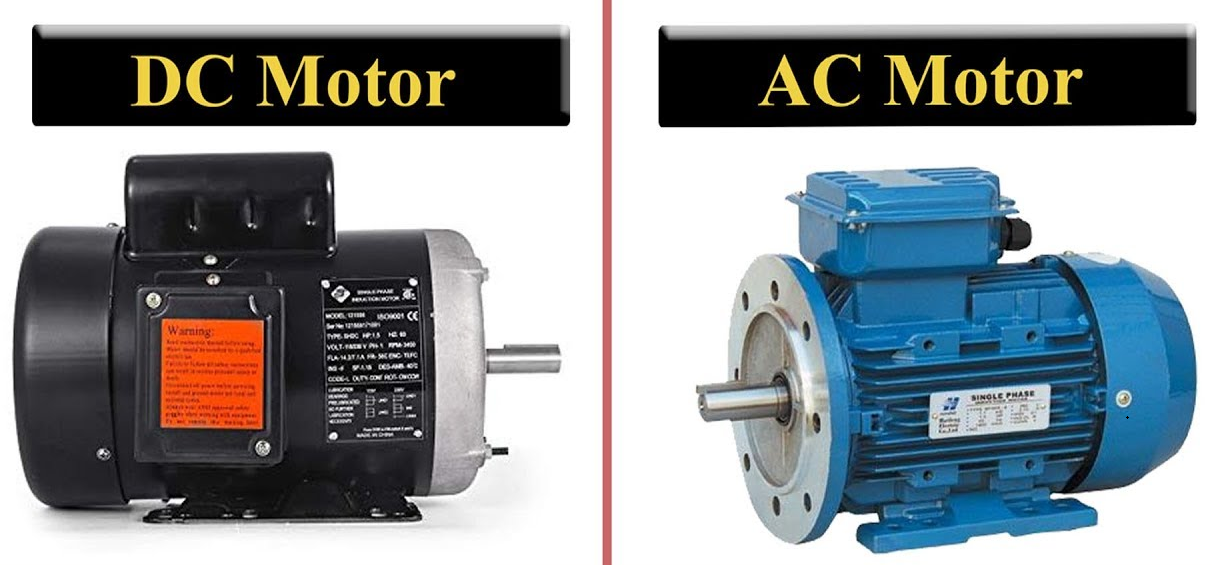Electric Motors
What is the engine? Engine Types
Motor: Machines that convert any energy into mechanical energy are called engines. Machines that convert heat energy into mechanical energy are called heat engines. Automobile engine is a heat engine.
Motor that convert electrical energy into mechanical energy are called electric motors. The engine of the washing machine, the vacuum cleaner is the electric motor.

a) Direct Current Electric Motors (DC)
Electric motors that convert direct current electrical energy to mechanical energy are called direct current electric motors. Toy motors powered by direct current batteries are direct current electric motors.
b) Alternating (alternating) Current Electric Motors (AC)
Electric motors that convert alternating current electrical energy into mechanical energy are called alternating current motors. The motor of the washing machine, which operates with alternating current, is an alternating current motor.
TYPES OF ELECTRIC MOTORS
a) Direct Current Motors and Types
Direct current motors consist of four main parts: inductor, armature, front and back covers.
1-Inductor: Consists of magnetic field poles and body. The body is the part to which the magnetic field poles and other parts are connected. The magnetic field is obtained by stretching the electric current over the coil wound on the iron core.
1- Armature : It is the rotating part in the engine body. Consists of windings and collectors. The collector slices provide the passage of the electric current through the windings, which rotate together with the body.
3-Front cover: It is used for closing the motor from the front, bearing the armature and holding the brushes. Brushes allow the passage of electrical energy to the collector slices.
4-Back cover: It provides the bed on the bed and the end of the armature and the motor to be closed from the back.
Direct current motors are three types according to the way the windings on the inductor and the armature windings are connected to each other.
Series Motors: Armature windings are motors connected in series to the inductor windings.
· Shunt Motors: Armature windings are motors connected parallel to the inductor windings.
Kompunt Motors: These motors have two winding groups in their inductors. One of these windings is connected to the industrial series and the other is connected in parallel.
b) Alternating Current Motors and Types
Alternating current motors are the most used electric motors both at home and in industry. The small powers of these motors generally have no windings in their rotors. Only their stators have windings. The rotors of alternating current motors have short-circuit conductors that act as windings. Small powerful alternating current motors are also called short circuit rotor motors. Since there is no electrical connection between the rotor and the stator, these motors will malfunction. Alternating current motors can be examined in two groups according to the facility where they are operated.
1- One-phase (single-phase) motors: They are motors that work with 220 volts voltage taken from the sockets of one-phase installations like in our homes. They have little power. Vacuum cleaner, washing machine motors are one phase.
2- Three-phase (three-phase) motors: These are motors that work with current taken from the triple sockets of three-phase installations in the workplaces. Three-phase motors run at 380 volts. The powers of the motors are more than the powers of one-phase motors. Inductors of large-power, three-phase motors are also made with short-circuit rotor instead of wound (with collar).
The motors of work benches such as lathes, milling and drills used in workplaces have three phases.
4- WORKING PRINCIPLES OF DIRECT CURRENT MOTORS
The principle of operation of direct current motors was introduced for the first time by Faraday. The principle of operation of DC motors found by Faraday; “If electric current is passed through a conductor in the magnetic field, the conductor will move.” It can be expressed in the form. The direction of the magnetic lines of the magnet consisting of N-S poles is considered to be from N to S. On the other hand, if electric current flows through a conductor, a magnetic field is created around it. The principle of operation of direct current motors is realized by the magnet and the magnetic lines occurring around the conductor passing electric current over each other.
Continuous rotation of the armature is provided by brushes that are in contact with the collector slices at every half cycle. The brushes change the direction of the current passing through the coils every half a revolution.
5-ELECTRIC MOTORS USAGE INFORMATION
When electric vehicles are used for the first time, the descriptions in the manual should be read carefully. It is necessary to fulfill what is required in the explanations for the efficient use of the vehicle. Explanations about the efficient operation of electric motors are written on the labels on the motor body.
The information on the label of an electric motor includes:
a- the name of the motor company: XXXX
b- model and type of the motor : K20C
c- engine serial number: Nr E 12657-46
The current drawn by the motor during operation